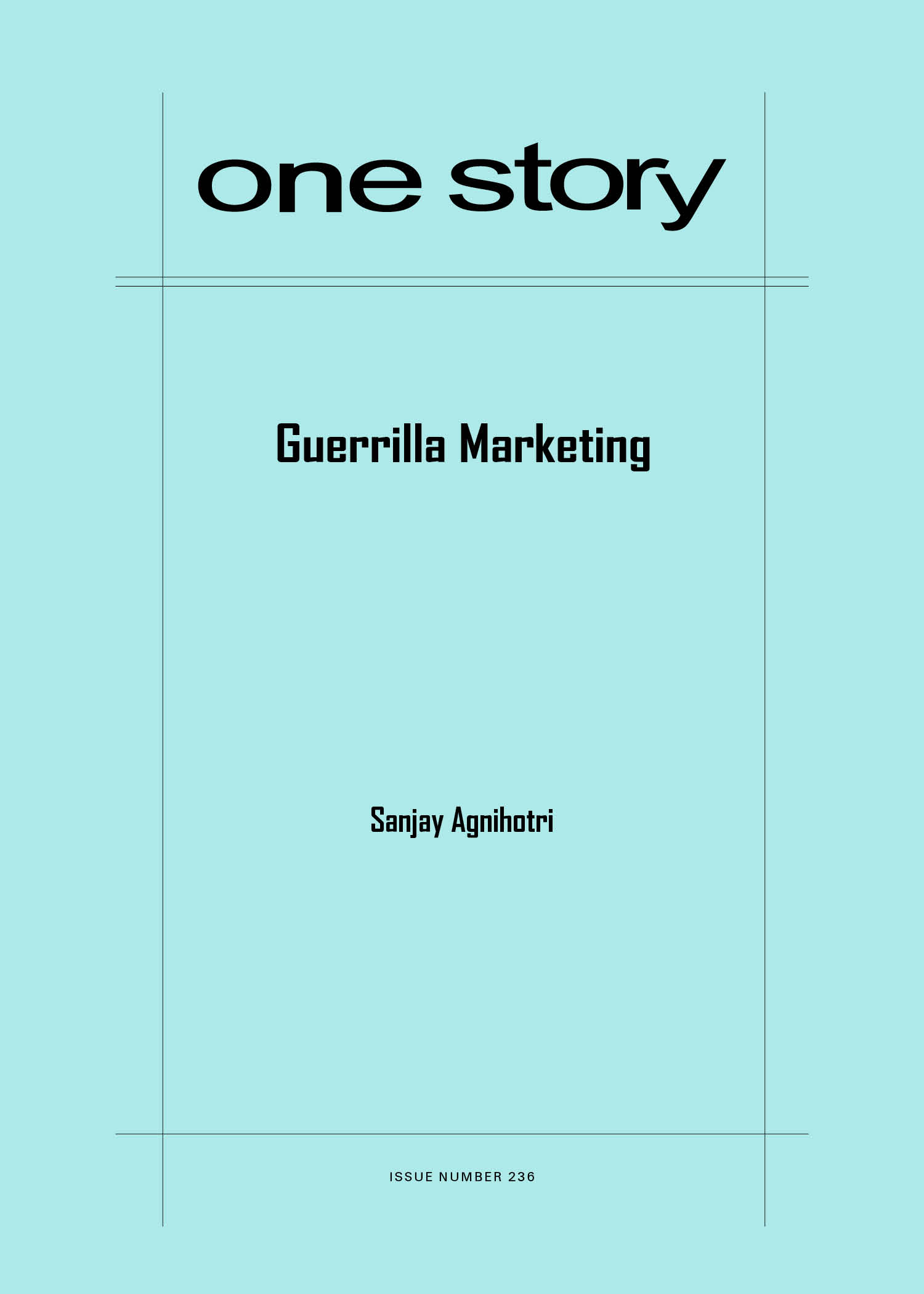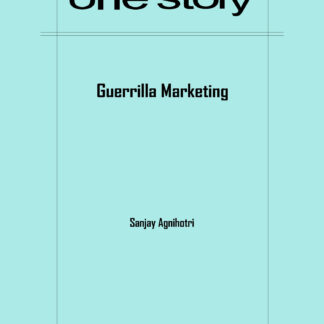
Guerrilla Marketing
236 in stock
Excerpt
Vikram dropped onto his knees and prayed to the goddess Lakshmi for a cash windfall. In less than six months, his only daughter, Heena, was getting married in Baroda, India, and he didn’t have money for the plane ticket home, let alone the wedding spread. If anyone should understand his desperation, it was the goddess of prosperity, and so—in the Balaji temple in Parsippany, New Jersey—Vikram bent down and prayed like he used to when he was a boy, when he believed the gods could deliver anything.
Vikram hadn’t come to the Balaji temple alone. He’d brought along one of his roommates, the ex-con and cook Sethi. Sethi, a lapsed Sikh, waited outside, claiming the eyeless statues of gods and goddesses spooked him. He leaned against a lamppost, smoking cigarettes and ogling the Hindu girls as they made their way across the parking lot to the temple for the free Prasad dinner.
For a couple of weeks now, Vikram had been investing in prayer, but tonight, when dollars didn’t fall from the temple ceiling, he grabbed the old Brahmin priest and pronounced the goddess Lakshmi a whore. The priest, who was accompanying a youth group, passed off his heavy load of Sanskrit texts, adjusted his cotton dhoti, and pushed Vikram out the temple doors.
Sanjay Agnihotri
Sanjay Agnihotri was born in Queens, New York City, and raised in New Jersey, India, England, and Saudi Arabia. He is the publisher of Local Knowledge, a literary and art journal, as well as the programmer and host of its long-running reading series in Manhattan. He lives in New Jersey with his wife and daughter. This is his first published story.
Will Allison on “Guerrilla Marketing”
Representations of South Asians in American culture have come a long way since Apu, the Kwik-E-Mart clerk on The Simpsons, first manned the cash register in 1990. Back then, there were few Indians in American fiction, film, or TV; they were usually relegated to supporting roles; and they tended to be convenience store workers, taxi drivers, or doctors. Today, however, actors of Indian descent—from Mindy Kaling and Priyanka Chopra to Aziz Ansari and Dev Patel—can be seen in a range of prominent, non-stereotypical, starring roles, and fiction writers such as Akhil Sharma, Kiran Desai, and Jhumpa Lahiri have reached a broad audience with their books.
Even so, I’d never encountered an Indian character quite like Vikram, the protagonist of Sanjay Agnihotri’s first published story, “Guerrilla Marketing.” Vikram is a 57-year-old former accountant from Baroda, India, who is struggling to survive as an immigrant worker in Parsippany, New Jersey. In American culture, the sort of suffering and exploitation Vikram endures is perhaps more commonly associated with undocumented workers from Mexico and South America—but in the case of Vikram and his peers, the exploitation comes not at the hands of white Americans but from other Indian immigrants who are higher up the food chain.
As Agnihotri acknowledges in his author interview, it’s a troubling story that risks sentimentality. Luckily for us readers, Agnihotri resisted the temptation to portray Vikram as a noble, suffering immigrant. Instead, Vikram is more of a sad sack, a guy with his own raft of bad habits, delusions, prejudices, misguided ambitions, and conflicting desires. In other words, he’s a real person on the page. We are excited to present another One Story debut, and we hope you find Vikram and his story as unforgettable as we did.
Q&A by Will Allison
- WA: Where did the idea for this story come from?
- SA: I’m not sure, because the creative process—at least for me—is a mystery, but two experiences come to mind. When I was a kid living in Saudi Arabia as part of the American ex-pat community, I witnessed firsthand the terrible living conditions of the migrant workers there, many of whom were from India, Pakistan, and southeast Asia. Their situation basically amounted to slavery. One day when I was maybe thirteen years old, I was riding my bike in a very remote area of Yanbu (where I should not have been) and came across a worker camp. I watched one of the migrants almost get beaten to death by the mutaween, the religious police in Saudi Arabia. One morning many years later in New Jersey, I saw a group of Indian men—Pakistanis, Bangladeshis, Sikhs—standing outside a shithole house in the town of East Hanover, dozens of men, some dressed as waiters, others as gas station attendants or limo drivers. There was no way that many men should have been living in that house. Most of them were no doubt illegals, and I knew then that I wanted to write about them, their lives, their struggles. I just didn’t know how, or what form it would take. Seeing them reminded me of the migrants in Saudi Arabia—the desolation and brutality of their lives, the exploitation. I started going out of my way to talk to guys like that, to learn their stories. Some are educated like Vikram, but most are not. Some are ex-cons with minor offenses. They are struggling, sending money home, trying to educate themselves, trying to survive.
- WA: What was the most challenging aspect of writing this story?
- SA: Avoiding sentimentality. You can be horrified by something, and that horror can turn into sentimentality. I think sentimentality and arrogance are the kisses of death for a writer. I’m thinking of William Carlos Williams’s lines: “No idea but in things,” and especially, “‘Beauty’ is related not to loveliness but to a state in which reality plays a part.”
- WA: Not long after we accepted “Guerrilla Marketing,” I was driving my daughter home from a softball game in Clifton, New Jersey, when we passed a man (who could have been Indian) on a street corner wearing a Statue of Liberty costume and holding a sign that read LIBERTY TAX—just like Vikram, the protagonist of your story. I nearly drove off the road. Was this just a coincidence, or is Vikram based on a real person?
- SA: Keep your eyes on the road, Will! Yeah, just a coincidence. It’s possible I may have seen someone like Vikram a long time ago. Or maybe I made him up. Either way, it’s about what you make of it as an artist. Ultimately it’s always about the human condition.
- WA: Who are some authors who’ve influenced your work?
- SA: It’s a long list, but just off the top of my head—and in connection with this story and the linked collection it’s a part of—there’s Theodore Dreiser; Sherwood Anderson’s Winesburg, Ohio; Isaac Babel’s Odessa Stories; Rohinton Mistry’s short story collection Tales from Firozsha Baag; William Carlos Williams; Nathaniel West; John Dos Passos; Louis-Ferdinand Céline; Jean Genet; and most importantly, Hubert Selby Jr., whose masterpiece, Last Exit to Brooklyn, is a tremendous influence. I love Lucia Berlin’s short stories. Joan Silber’s new novel, Improvement, is extraordinary. I also must mention my hero, Albert Camus, because coming across his work was a profound intellectual experience, and he informs my way of being in the world.
- WA: One theme that drew me to your story is the loss of dignity endured by your characters. What made you want to give voice to this particular underclass of immigrants?
- SA: I haven’t seen this class of Indian immigrants represented accurately. When you come across Indians in movies or on TV, the portrayals are usually one-dimensional and stereotypical—either a convenience store clerk, like Apu on The Simpsons, or, at the other end of the spectrum, a “good doctor” type or IT cubicle wizard. When it comes to Vikram, I don’t think he’s so different from many of us, to some degree—the self-deception, the lying, the superstitious thinking. Sure, he wants to pay for his daughter’s wedding, but really his dream is to become like the guys who are exploiting him. He wants to hang with Ginger and Bhatti. He tries to rationalize everything, even when he knows he’s being screwed over. He’s stuck, caught in the trap, like all of us.
- WA: How long did it take you to complete this story?
- SA: I’m not sure—maybe three years, off and on. I did dozens of drafts. The first draft was at least twice as long as the final draft, which hardly resembles the first draft, but that’s how it is with all of my stuff. I like it that way: the adventure and risk of never being certain if or how a story is going to turn out.
- WA: Sanjay, we feel lucky to be publishing your first story. When and how did you start writing fiction?
- SA: I was seventeen when I wrote my first creative piece. It was the first time I felt connected to the world. I was a terrible student. I failed almost everything and graduated high school by the skin of my teeth. I hated school; I hated the authoritarian structure. I was bored. I was interested in everything outside of what was being taught in the classroom. My mother introduced me to books, gave me my love of literature. She was English and a voracious reader. Dickens, Hardy, Lawrence, Somerset Maugham—I devoured that stuff. Before long I was reading Dostoevsky and Céline. I think deep reading inspired me to write, as it does most writers. I also wanted to write for my literary heroes. I’m sure many artists have that desire.
- WA: What are you working on now?
- SA: I’m finishing stories for a linked collection that includes “Guerrilla Marketing.” I’m also in the beginning stages of a novel about an Indian physician and his son who are indicted for Medicare fraud and for running an opioid syndicate. The book explores the repercussions for the physician’s family and his community.
- WA: What is the best bit of advice about writing you have ever received?
- SA: Get a completed rough draft down. There’s plenty of time to revise; that’s the hard work and fun. And I have to go to the great master Isaac Babel for a slice of brilliance: “No iron spike can pierce a human heart as icily as a period in the right place.”
